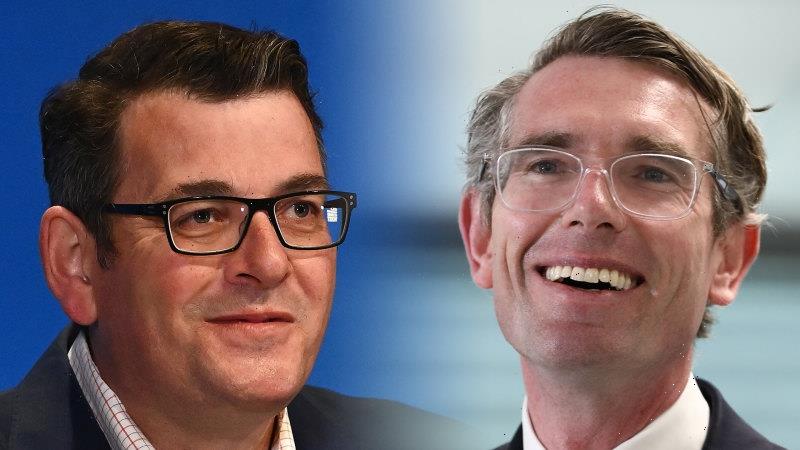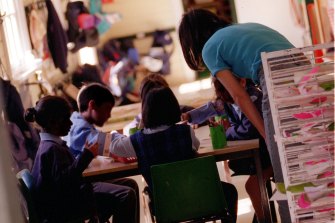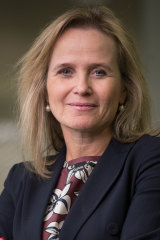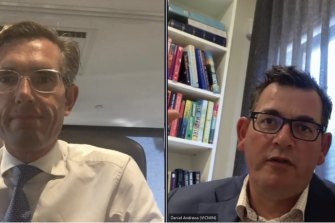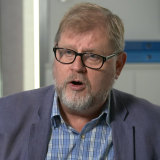For our free coronavirus pandemic coverage, learn more here.
What does living with the virus mean? This week and next, parents of school aged kids in Victoria and NSW will have a much better sense of it after their children walk out the front door, school bag strapped to their back, and return to their classrooms while the pandemic rages around them.
When they get to school, whether government or non-government, city or country, Victoria or NSW, the public health measures they encounter will be all but identical; masks for the kids, booster shots for teachers, air purifiers or open windows in the classrooms and for homework, a stack of rapid antigen tests. For what feels like the first time in a very long time, Australia’s two most populous states are starting a new school year on the same page.
Victoria and NSW adopted nearly identical back to school policies to ensure kids could return to class at the start of term 1.Credit:Quentin Jones
The implications of this go well beyond schools. As Doherty Institute director Sharon Lewin explains, Australia before the arrival of COVID-19 had a strong tradition of quarantining public health from political divisions. The NSW-Victoria accord, now evident in a pragmatic partnership between Dominic Perrottet and Daniel Andrews and more importantly, broad alignment in how the two states are managing the Omicron wave, has reframed the nation’s pandemic response and injected a much needed booster shot of public confidence.
“I think it is fantastic,” Professor Lewin says. “Public health policies should be driven by the best science and evidence and when you have variation in different states it raises people’s doubts about what is really driving decisions. The greater alignment we can have not only makes sense from a scientific point of view, it gives the public much more confidence because they see consistency. It depoliticises public health.”
Doherty Institute director Sharon Lewin says the NSW and Victorian collaboration has helped depoliticise public health.Credit:Jason South
If you had suggested in October last year that Andrews and Perrottet would be the political leaders most likely to unite our pandemic response, you might have been checked for evidence of a COVID fever.
On the day that Perrottet was sworn in as NSW premier, Victoria was yet to reach the peak of its Delta wave of infections, an epidemic the Andrews government openly blamed on NSW’s failure to contain its outbreak and a slow vaccine roll-out by the federal government. Andrews is a hard-nosed, machine man of the Victorian ALP and a social progressive who had repeatedly locked down his state to keep COVID at bay. Perrottet, a product of student and back-of-house Liberal Party politics, was a young, socially conservative leader whose libertarian ideals sat uncomfortably with Australia’s risk-averse pandemic response.
Upon closer examination, you can see why this political odd couple has found common ground. Andrews’ success throughout the pandemic has not been the stubbornness of his resolve but rather, his preparedness to pivot. Witness the agility with which Andrews, in September last year, abandoned his long-standing support of COVID-zero as a public health goal and accepted that COVID infections would be a part of normal life in Victoria for the foreseeable future. Perrottet, although his ideological moorings are far removed from those of Tim Pallas, a former ACTU assistant secretary, worked closely as NSW treasurer with his Victorian counterpart to establish the Board of Treasurers, a forum to advance improvements in federal/state financial relations.
“I learned a lot from other treasurers and I hope I was able to help them,” Perrottet tells this masthead. “Now as Premier, I take the same approach. We’re not always going to agree and have the same approach. We’re facing different challenges in different jurisdictions but we can come together and learn from each other. Unity is what’s going to get us through, not division.”
Perrottet, in his speech to the National Press Club in December, canvassed a national reform ambition which will require the support of his fellow state leaders.
On his collaboration with Daniel Andrews, Perrottet notes that Victoria and NSW have similar populations, similar demographics and are facing the same pandemic. “This is about people, not politics,” he says. “If you don’t put politics aside in a pandemic then you are doing your entire country a disservice.”
Daniel Andrews, although less expansive, affirms his commitment to what has become a highly productive partnership. “Victoria and NSW have had similar experiences of the pandemic,” he says. “Where there is shared experience and mutual benefit we’ve worked collaboratively and we’ll continue to do so.”
The Victorian Premier this week confirmed that on Monday, the day the states co-ordinated the timing and content of their back-to-school policy announcements, he had a lengthy conversation with Perrottet, as he does most weeks. If the two premiers released the audio from their regular Dom and Dan Zoom meetings, it would make for a lively podcast.
United force: NSW Premier Dominic Perrottet and Victorian Premier Daniel Andrews have held regular Zoom meetings to co-ordinate their COVID policies. Credit:Daniel Andrews
Perrottet’s first foray into pandemic politics did not augur well for future collaboration. On October 15, just 10 days after he was sworn in, the NSW Premier unilaterally announced that from November 1, all international travellers, subject to being fully vaccinated, would be able to enter NSW without the need to quarantine. The policy change – the first step towards dismantling our Fortress Australia border arrangements – was consistent with what the Victorian government was independently working towards, but Andrews was blindsided by the Perrottet announcement. From this shaky start however, a collaboration began to take shape.
Within a week of the NSW announcement, Victoria publicly joined NSW by ditching its requirement for international arrivals to quarantine. On November 4, a joint statement was issued by the offices of Andrews and Perrottet announcing that for the first time in four months, the border between the two states would be fully open. “NSW and Victoria are normalising living with the virus,” the statement read. It was a policy change consistent with the vaccination milestones within the national plan for re-opening but significantly, Victoria and NSW had made it together.
It is a case of NSW and Victoria taking politics out of the pandemic. Rather, both leaders realised that, for all their political differences, their interests and those of their states were fundamentally aligned. Victoria, like NSW, had come to accept that COVID could not be eradicated by public health interventions. The most recent Delta outbreak had revealed public fatigue and dwindling compliance with COVID restrictions. Mass vaccination had recalibrated the relationship between COVID infection, severe illness and death. The emergence and unprecedented spread of the Omicron variant, rather than challenging these assumptions, cemented them. The resultant transformation of our pandemic response, in a matter of weeks, has been profound.
On December 6, just days after a Sydney school student was confirmed as the first known case of Omicron spread within Australia, Premier Andrews vowed to keep Victoria’s border with NSW open and where possible, harmonise the COVID policies of the two states. “If Victoria and NSW are working closely together, I think that’s a good thing for the rest of the country as well,” he said.
Two weeks later, with Omicron starting to replace Delta as Australia’s dominant strain, NSW and Victoria issued a second joint statement announcing that international arrivals will only need to isolate until they return a negative test.
By this stage, key staff within the offices of the Premiers had established working relationships with their counterparts and had begun sharing information on sensitive political decisions. Planning was already well advanced on a joint decision that would resonate more deeply with Australian families than any change to border policies; a return to classroom teaching, on day one of term one.
The Victoria/NSW partnership, having endured the peak of the current Omicron wave, has recast pandemic politics. Whereas previously, the federal government sought to uphold NSW as a COVID exemplar a NSW/Victorian unity ticket on most public health measures dulls these attacks. Instead, NSW and Victoria have at crucial times used their combined strength to force a change to national policy.
The week before Christmas, state health ministers Brad Hazzard and Martin Foley wrote to their federal counterpart Greg Hunt urging the Commonwealth to reduce the interval for COVID boosters. Their intervention was prompted by the release of UK data showing that, after 20 weeks, vaccination against COVID provided zero protection against infection with Omicron. The issue was referred to ATAGI, which recommended on Christmas eve that the interval be shortened from six to four months.
To appreciate how far removed we are from the pandemic settings in place at the start of this summer, think back to what living with COVID used to mean. Once stay-at-home orders lifted, we could go to work and to shops and bars and restaurants but, if any of those places recorded a positive case corresponding with when we were there, we would be told to quarantine for two weeks. If any kids got sick at school, the rest of their class would be sent home and in some instances, the entire school would shut.
Infectious diseases expert Professor Robert Booy.
Remember when workplaces were closed for deep cleaning? When getting tested was something that required a trip to your local clinic and a lengthy wait for results instead of a self-administered check, while the kettle boils, at your kitchen bench? When returning from overseas meant being unable to leave a hotel room for two weeks? When getting COVID was something we thought we could avoid?
Robert Booy, an infectious disease expert with the University of Sydney and Sydney’s Westmead hospital, says one of the most significant changes is that getting the virus has itself been normalised. Anyone reading this in Victoria and NSW has either had the virus or has family or friends who have been infected. Professor Booy can speak from personal experience; on the day he spoke to this masthead, he was on his sixth day of isolation after testing positive to COVID. He is triple vaxxed and his symptoms, like those experienced by most fully vaccinated people, were short-lived and mild.
“Omicron is clearly a dramatic change from Delta,” he says. “It is much less severe and it is incredibly more transmissible. It has created a situation where infection in the community has become the normal. Half the people in my street, who are careful, have gotten infected anyway. I’m an example of being protected and, having been exposed, getting a mild infection only. Getting that mild infection has been a boon. I’ve gotten better quickly and I have got better protection against what COVID throws up next.”
Professor Booy, like Professor Lewin, is delighted to see NSW and Victoria now in lock-step on so much of their pandemic response. An expert in COVID infections in children, he has been a staunch advocate for a return to classroom teaching with sensible mitigation measures. He has also been part of a broad research team that has collaborated, across bureaucratic and state divides, to inform the policies which enabled children to return to class. That research team included senior bureaucrats from the NSW health and education departments who, in turn, shared what information they gathered with their Victorian equivalents.
Professor Booy’s mantra, one shared by the World Health Organisation and now, formally adopted by national cabinet at the urging of Andrews and Perrottet, is that schools should close for public health reasons only as a last resort and only for the shortest time possible. This is a radical rewriting of Victoria’s approach in 2020 and 2021, when classroom teaching was repeatedly disrupted and kids kept home for entire school terms.
Professor Lewin observes that the unanticipated emergence of Omicron, a variant that freely infects the fully vaccinated but puts 70 to 80 per cent fewer vaccinated people in hospital, turbocharged the speed of planned changes to our pandemic response. Our path out hasn’t changed direction; we are just bolting along a route we thought we’d be walking before the first Omicron case was identified in South Africa.
As dramatic as the changes have been, there are potentially more to come. Once there is no constraint on the availability of rapid antigen tests – something Professor Lewin expects to see within the next few months – our management of COVID cases is likely to be further overhauled so that a COVID infection, like a cold, doesn’t disrupt the lives of household members who aren’t sick. The likely availability of oral antivirals, perhaps before the winter, will expand treatment options without the need to go to hospital.
These changes, like those we have already gone through, will create uncertainty in people who remain sceptical of our capacity to return to normal life while COVID circulates widely in the community. But, so long as their accord holds, you won’t hear any argument between the premiers of NSW and Victoria. And that’s good for all our health.
The Morning Edition newsletter is our guide to the day’s most important and interesting stories, analysis and insights. Sign up here.
Most Viewed in National
From our partners
Source: Read Full Article
